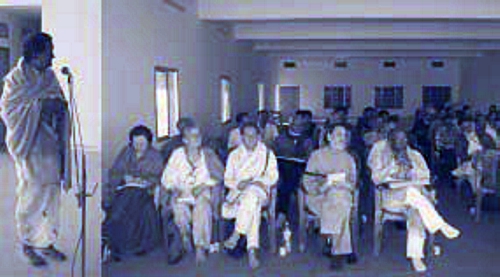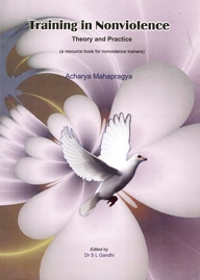The basic element of training in nonviolence is a change of heart or mental training. The following specific principled formulas are required to be part of the training for bringing about a change of heart.
Factors causing violence effects
1.
Greed
Tendency to acquire
2.
Fear
Manufacture and use of armaments
3.
Hostility
Tendency to take revenge
4.
Anger
Internecine quarrels
5.
Egoism
Hatred and discrimination based on considerations of caste and colour
6.
Cruelty
Exploitation and killing
7.
Intolerance
Sectarian Strife
8.
Absolute
Obduracy as opposed to tendency to disregard the relative views of others.
9.
Absolute behaviour
Tendency to practise non-cooperation in communal life.
These instincts turn people violent. Change of heart means overcoming these instincts and cultivating new refined habits instead.
Formulas of Mental Training
The antidote to greed
Training in freeing oneself from the infatuation for material objects and the body.
The antidote to fear
Training in cultivating fearlessness and in strengthening the will not to manufacture or trade in armaments.
The antidote to hostility
Training in cultivating friendship and in eschewing the tendency to take revenge.
The antidote to anger
Training in learning to forgive.
The antidote to egoism
Training in practising humility, nonviolent opposition and non-cooperation with injustice.
The antidote to cruelty
Training in cultivating goodwill for other sects and the ability to put up with diverse views.
The last two factors causing violence can be countered by training people in relativism of thinking and behaviour. Negative feelings are to be countered by training in feeling positively.
Stopping nonessential violence
Training in nonviolence will have as one of its constituents making the people aware of the need to give up nonessential violence. Wastage of water, excessive mining, killing innocent creatures and people are examples of nonessential violence. It has made man cruel and has disturbed the balance of nature.
Physical health and nonviolence
There is an intrinsic relation between physical health and nonviolence. Illhealth generates violence. One of the factors responsible for people committing suicide is inadequate sugar in the blood. Likewise, disorders of liver and spleen also contribute to violent thoughts. Therefore, training in differential dietetics and Science of Healthy Living is a vital component of training in nonviolence.
Economic health and nonviolence
Training in the following subjects is necessary for the economic health of an
individual as well as society:
- Voluntary parting with wealth
- Non-acquisitiveness
- Decentralization of the economy
- Economics and World Peace
- Economics and a Healthy Society
- Legitimate Means of Making Money
- Just Distribution of Wealth
- Restraint in consumerism and limitation of wants
What needs to be emphasized is that physical, mental, emotional and economic health contributes to the creation of a nonviolent society. They have, therefore, to be the bases of training in nonviolence.
The base and field of experimentation in training in nonviolence
The success of the methodology of training in nonviolence depends on the development of an individual mentality irrevocably committed to nonviolence. This has to be practised in the following areas:
- Individual as a member of the family
- Individual as a social being
- Individual as a citizen of a nation
- Individual as a citizen of the world.
 Acharya Mahaprajna
Acharya Mahaprajna


